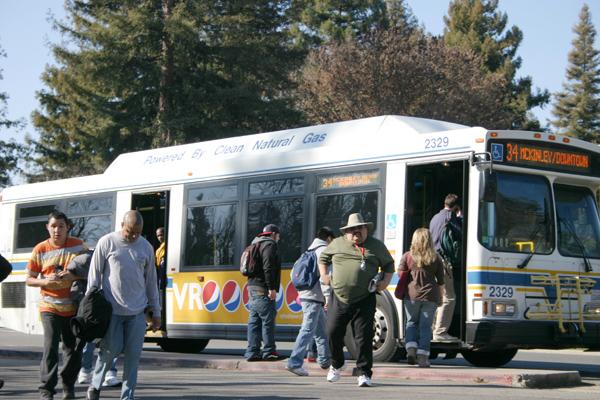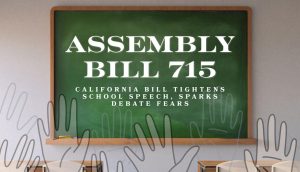Fees rise, alternative rides

With the recent tuition and parking permit fee increases, students explore alternative transportation such as riding the bus or taking the light rail to cut expenses.:Claire Padgett
February 12, 2009
With the semester’s increasing fees, Debbie Harris, a first-year master’s student and mother of two kids, said she had not been able to afford a parking permit. Harris tried carpooling with other people, but class schedules always conflicted.
Harris is just one example among many Sacramento State students who have entered the spring semester under more financial strain and paying more fees in an already tight economy.
The University Transportation and Parking Services said that Sac State has not raised parking fees in five and a half years. Increased parking fees are needed for the higher costs, such as gas, safety, operation and parking facilities maintenance, as well as debt payments for the construction of Parking Structure III.
Beginning this semester, parking permit prices for students including Residence Hall students increased from $108 to $153, with another two percent increase each year beginning in 2010.
Lauren Pascual, freshman forensic biology major and gymnastics team member, said her teammates are complaining about the parking fee increases.
“We talk to our coach about our problems, but I don’t know how much they can do,” Pascual said.
Pascual, like many other students, is trying to buy less, and only buy what she needs, instead of what she wants.
Harris also tried to find areas to cut costs. “We don’t eat out anymore because we can’t afford to,” she said.
Avi Luu, freshman, said he carpools with people to get to school.
“I save up money for gas, and I don’t go out anymore,” Luu said.
Megan Bananzadeh, senior human resource major, said that the parking fees went up a lot since she first started going to Sac State.
“Just one more cost. You already have to worry about gas prices. It’s hard,” Bananzadeh said.
Beginning Sept. 1, 2009, Residence Hall students will pay $198 for parking, up from $153 now.
Victoria Hanson, a Jenkins Hall resident, said that she does not yet have a car, but the fees will “put us more in debt.”
“We can’t really do much. People can complain, but we’re still not going to get money,” Hanson said.
Associate vice president for Business and Administrative Services Abigail Stone said students have alternatives to getting to campus, such as riding the light rail at no cost with their OneCard. The Student Commuter Passes are available at the UTAPS office, OneCard Office, Associate Students Inc. in the University Union, and the Student Financial Services Center (SFSC) in Lassen Hall.
“While it is too early in the semester to assess, we may see a reduction in the number of student permits sold as compared to recent semesters,” Stone said.
Senior biology major Jesse Chea said he carpools and sometimes buys a daily parking permit.
“I park at a friend’s place and walk over,” Chea said.
Chea said that people should get involved in student politics, so their voices are heard about the fee increases.
Hilary Hendrix, freshman business major, found another alternative to the parking fee increases by splitting a parking permit cost with someone. Hendrix now carpools and buys her books online, with book prices also going up.
Over the course of a decade, state university fees, including campus fees for full-time students, have increased by 71 percent from $1,982 in 1997-1998 to $3,854 in 2008-2009 at Sac State, according to the California State University website.
CSU, Long Beach has the lowest fee at $3,392; CSU, San Luis Obispo has the highest fee at $5,043 in 2008-2009.
According to a summary of Gov. Arnold Schwarzenegger’s budget proposal for the CSU, the CSU budget will not increase by the compact funding of $217.3 million as originally promised in the Higher Education Compact agreement made with Chancellor Reed.
The Higher Education Compact agreement was a multi-year plan for providing sufficient basic operating and capital funding needed through the remainder of the decade to support the CSU’s core missions of teaching, applied research and public service.
In exchange, the CSU would focus their resources to address long-term accountability goals for enrollment, student fees, financial aid and program quality.
Stacy Hayano, the university budget officer, said that with the absence of the compact, funding will result in CSU campuses limiting the enrollment to the 2008-2009 full-time equivalent student targeted levels.
Hayano added that mandatory costs, such as employee health and dental benefits, new space and energy cost increases, as well as financial aid costs, such as university grants required for the 2009-2010 will still need to be funded through other means, like student fee increases.
“However, it is predicted that the increase in student fees will fall short of funding these additional costs,” Hayano said.
Assistant vice chancellor Allison G. Jones sent out a memorandum to the CSU campus presidents stating the agreed targeted enrollment was 342,893 full-time students for 2009-2010.
Director of financial aid Craig Yamamoto said the office will continue to give out financial aid awards for the students’ cost of attendance, contingent upon eligibility requirements and available funding.
“I think students will either have to apply for scholarships, borrow more in student loans, work, or seek funding from their families to make up for any fee increases which are not covered by financial aid,” he said.
ASI executive vice president Roberto Torres said that ASI was shocked to hear about the parking fees; he knows students are upset.
“I encourage students to carpool,” Torres said.
Catherine Robledo can be reached at [email protected]

























































































































